American Indian Katsina (Hopi)
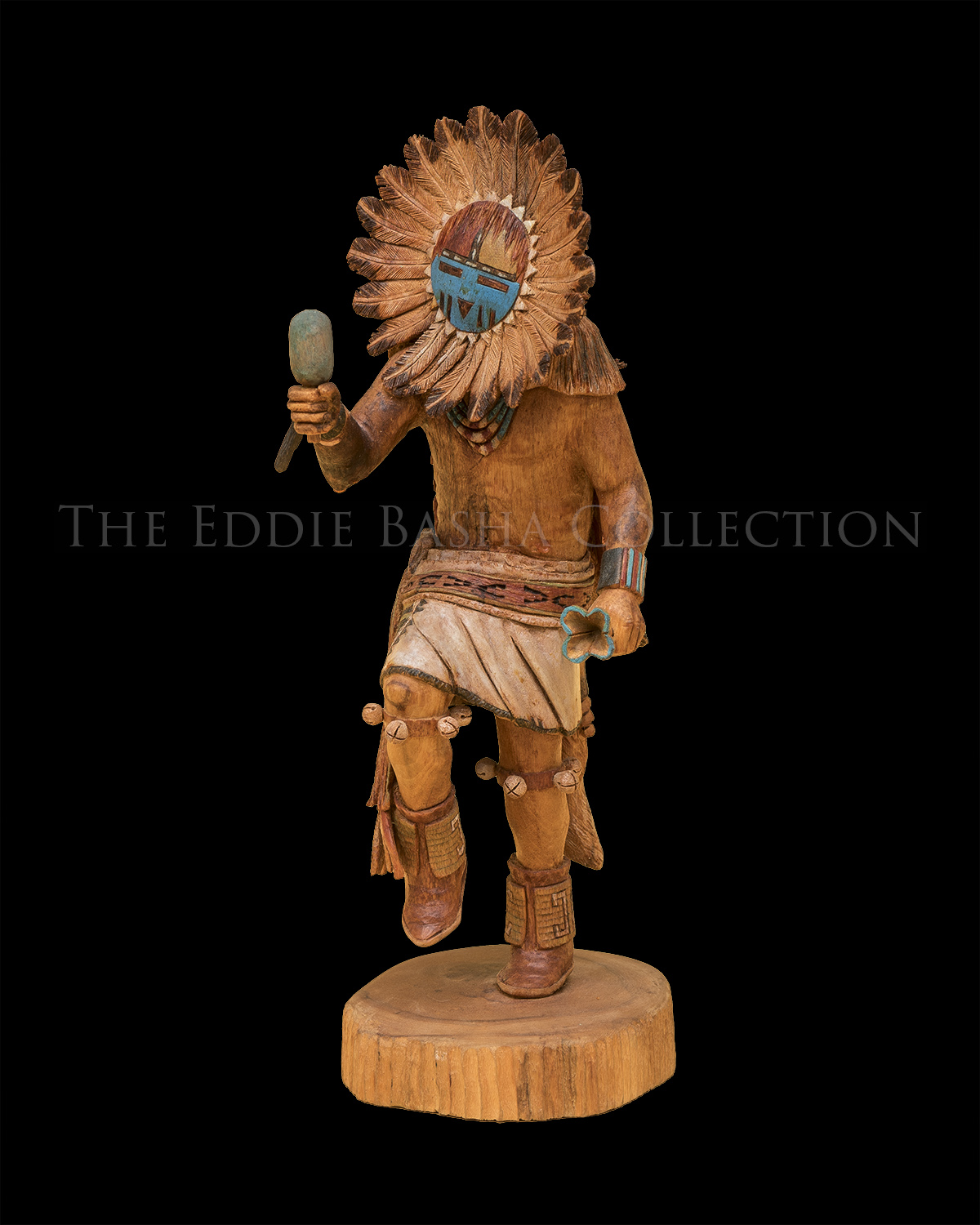
Taawa (Sun) Katsina | Wally Navasie (1962-2008)
Artist: Hopi
Description: Cottonwood Tree Root | Dimensions: 15”h x 6”w x 5”dkatsina
This traditional Hopi carving by Wally Navasie is of a Taawa or Sun katsina that typically stands to the side in dances and can appear with a spruce tree in his left hand and a bell in his right. He may also appear in mixed dances with a flute in his left hand. Here, Navasie depicted Taawa with a gourd rattle in one hand and a flower in the other. The sun face represents warmth, shelter for the old, a bright future, and playfulness for the young.
Navasie was a Hopi carver from the First Mesa. He carved most of his life and was well known for his butterfly maidens and other sculptural pieces. He is featured in Theda Bassman’s book, “Hopi Kachina Dolls and Their Carvers.”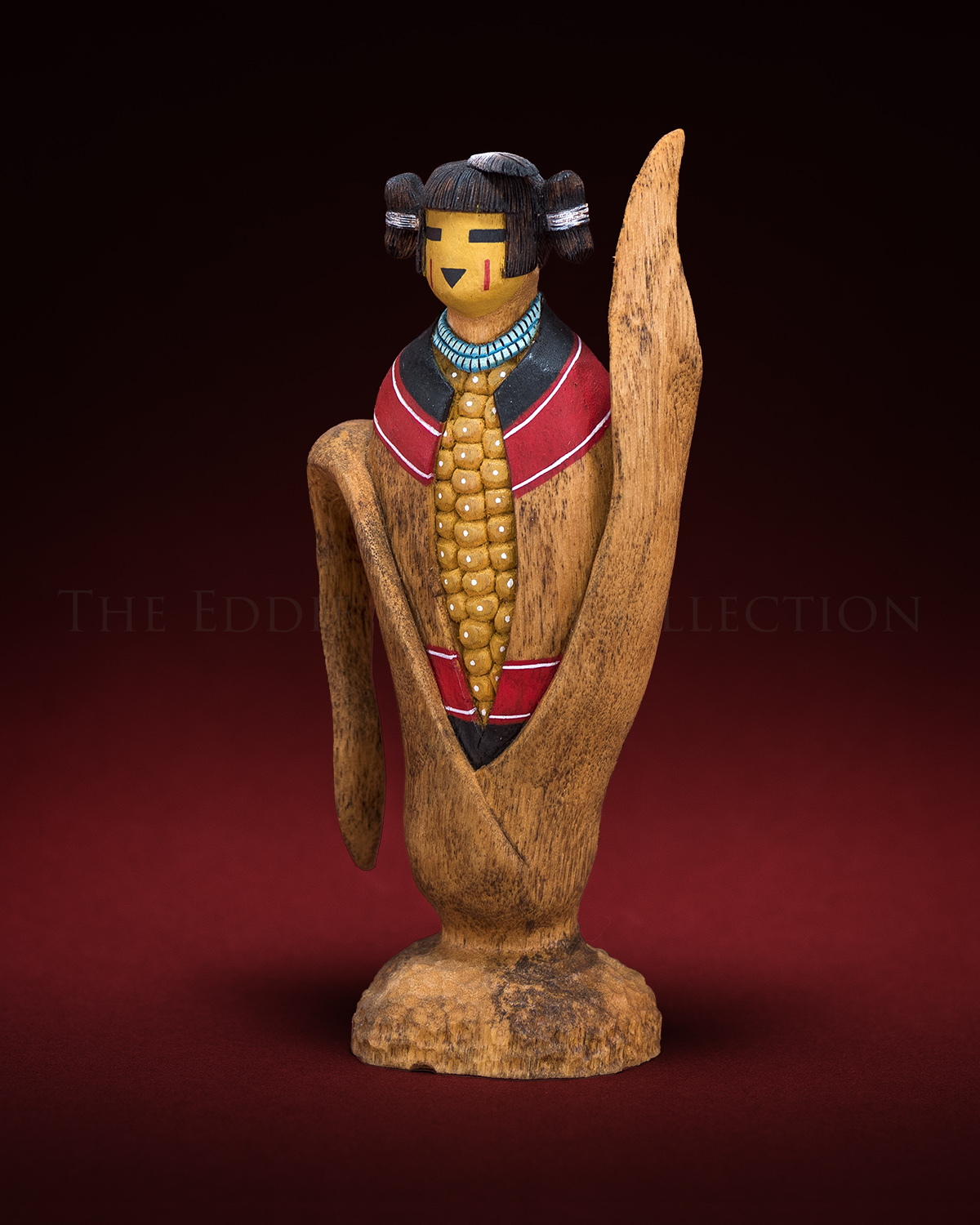
Corn Maiden| Maurice Tawesa Nutumya | Maurice Tawesa Nutumya
Artist: Hopi
Description: Cottonwood Tree Root (2006) | Dimensions: 6 ¾”h x 3”w x 2”dkatsina
The petite-sized Corn Maiden by Maurice Tawesa Nutumya stands a mere 6 ¾” high. But its size doesn’t detract from its graceful, elegant lines. Her hair features traditional squash blossom, or butterfly whorls signifying her unmarried status as she emerges from the corn. As a maiden, she symbolizes potential, and the gifts received related to the growing and harvesting of corn.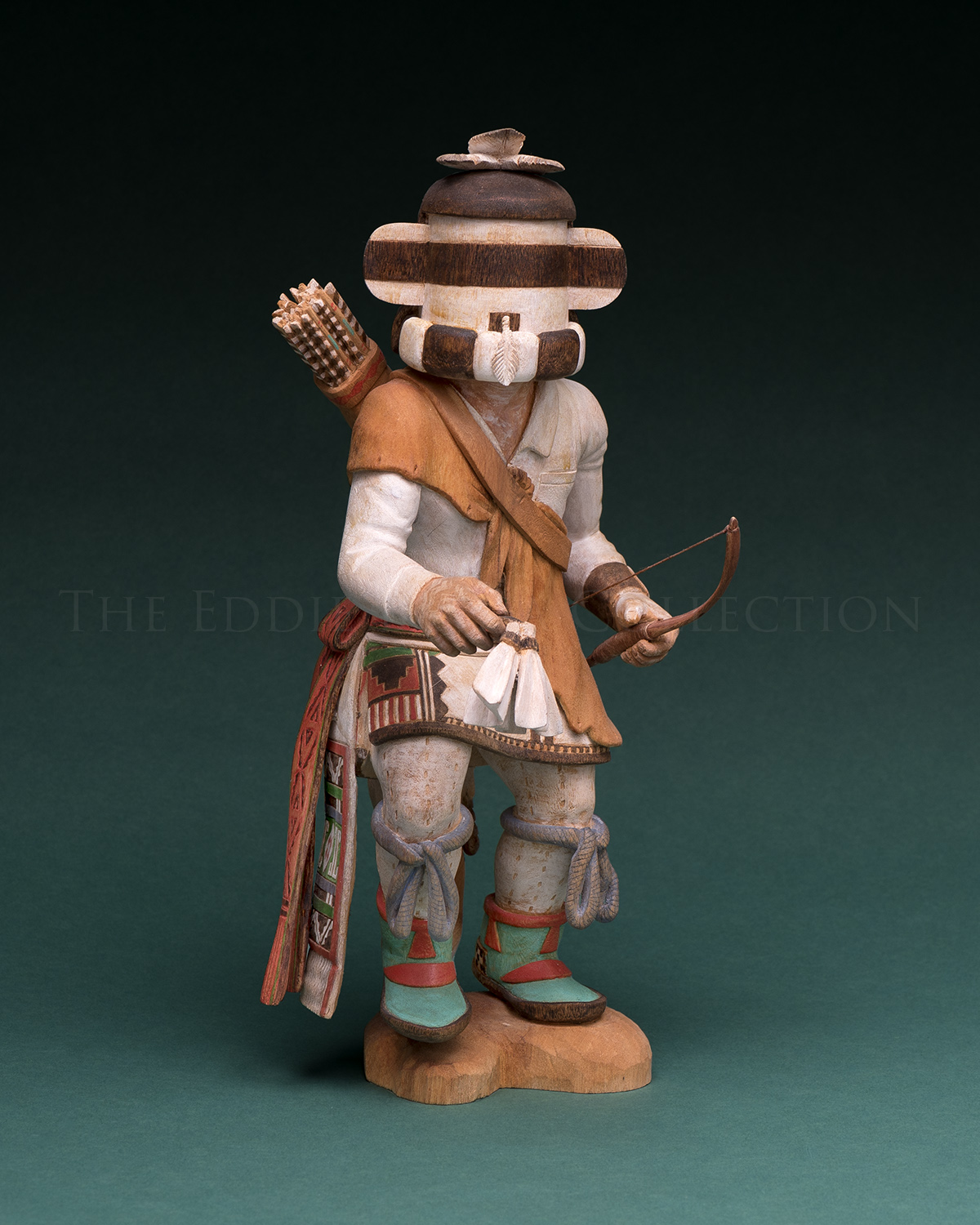
Hututu | Lowell Talashoma (1950-2003)
Artist: Hopi
Description: Cottonwood Tree Root | Dimensions: 13”h x 7”w x 6”dkatsina
Though originating from the Zuni culture, the Hopi adopted the “Hututu” katsina. It is known by the same name in both cultures and was derived by the sounds that he makes. He appears at the Bean Dance on First Mesa among other katsina. Here Hututu is depicted holding a bow in one hand, a quiver full of arrows slung over his shoulder, and an ornately brocaded hip sash tied around his waist.
Hopi katsina artist, Lowell Talashoma (1950-2003), was born on the reservation but raised by another family in Utah. His artistic abilities were apparent early on as he often drew illustrations for stories he’d read. On a particular visit to the reservation, Talashoma refused to return to Utah and from there he began to immerse himself in the Hopi culture. His carvings are known for their ability to convey movement and action and for their fine detailing. Several of his pieces were also cast in bronze. Talashoma garnered numerous awards throughout his career in competitions and exhibitions including top honors from shows at the Museum of Northern Arizona in Flagstaff, the Santa Fe Indian Market, and Gallup Inter-Tribal Ceremonials. He also won the Sandra Day O’Connor Special Award in the Katsina Category at the Heard Museum Guild’s Annual Indian Market.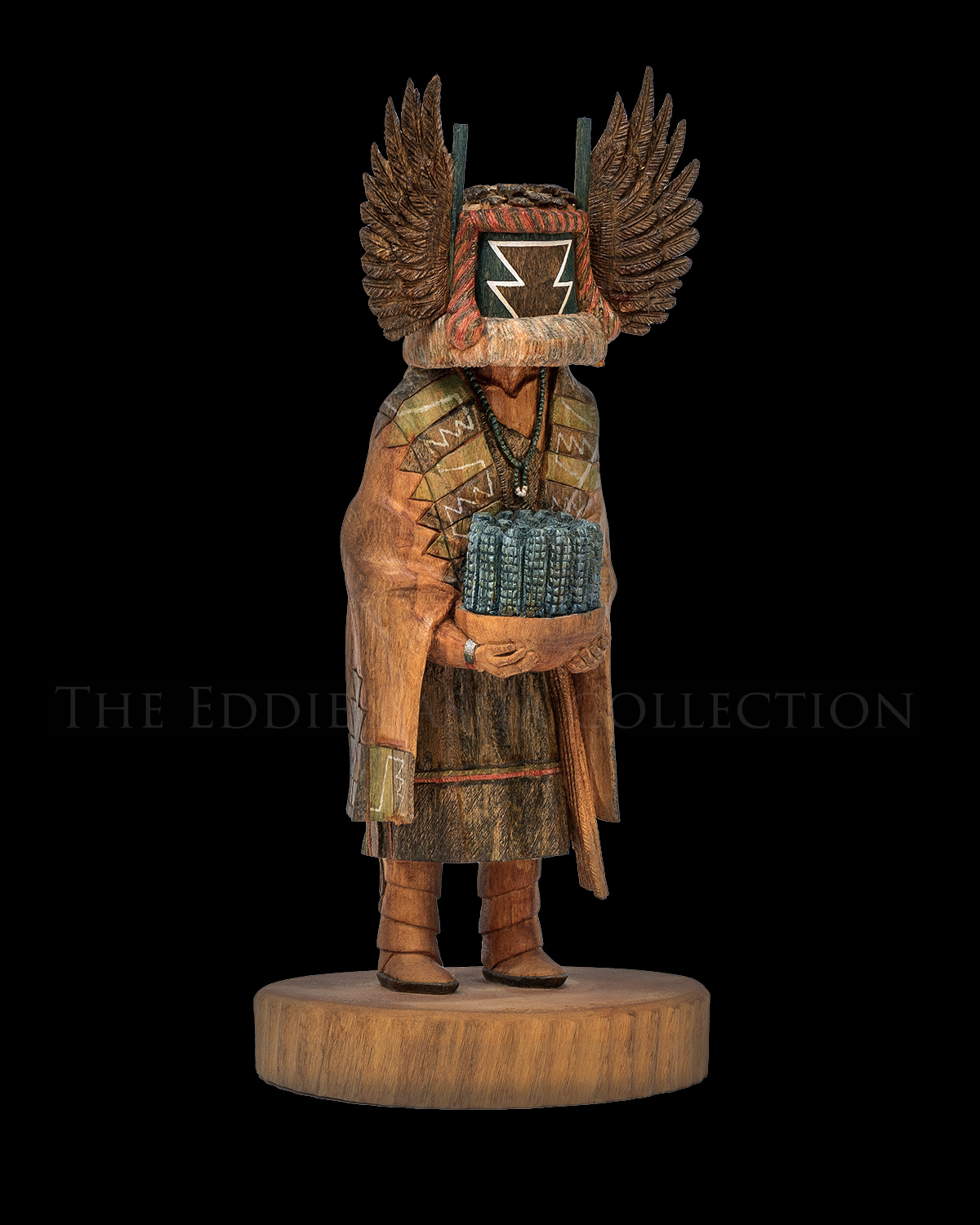
Blue Corn Maiden | Leon L. Dallas (b.1960)
Artist: Hopi
Description: Cottonwood Tree Root (1986) | Dimensions: 15”h x 7”w x 5”dkatsina
Blue Corn Maidens typically appear at the Soyal Ceremony, December 21, which marks the winter solstice as the shortest day of the year. Participants ceremonially bring the sun back from its long slumber, mark the beginning of another cycle of the wheel of the year and work on purification. Blue Corn Maiden’s presence is a prayer for corn. She also honors Mother Earth for her continuing ability to feed her children. She is a reminder for all people to be thankful for their many gifts.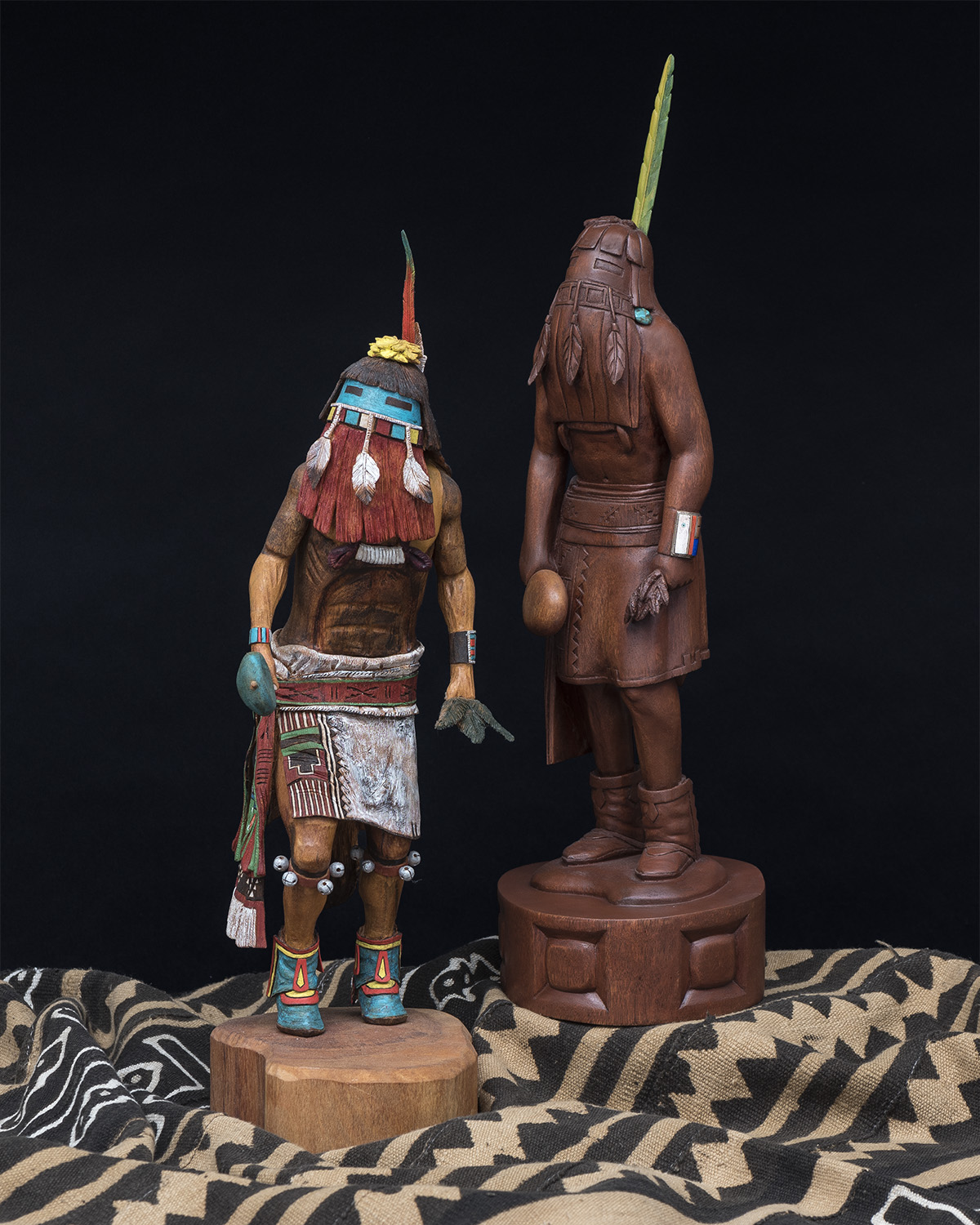
Red-Bearded Long Haired Katsina (Left) | Cecil Calnimptewa (b. 1950) Red-Bearded Long Haired Katsina (Right) | Brian Honyouti (1947-2016)
Artist: Hopi
Description: Cottonwood Tree Root | Dimensions: 20”h x 5”w x 8”d (Left)katsina
Cottonwood Tree Root | Dimensions: 21 ½”h x 7”w x 7”d (Right)
The Hopi Long-Haired Katsina (Angak’cchina) is the bringer of gentle rains and flowers. The long hair worn loose down the back resembles the falling rain with the eagle breast plums rising like clouds above.
Each of the master carvers, Cecil Calnimptewa (left) and Brian Honyouti (right), conveyed their own interpretation. While Calnimptewa chose a traditional painted path, Honyouti chose a nod to modernity and incorporated natural materials such as turquois nuggets for the earbobs and gold, silver, coral, lapis and petrified wood for the bracelet.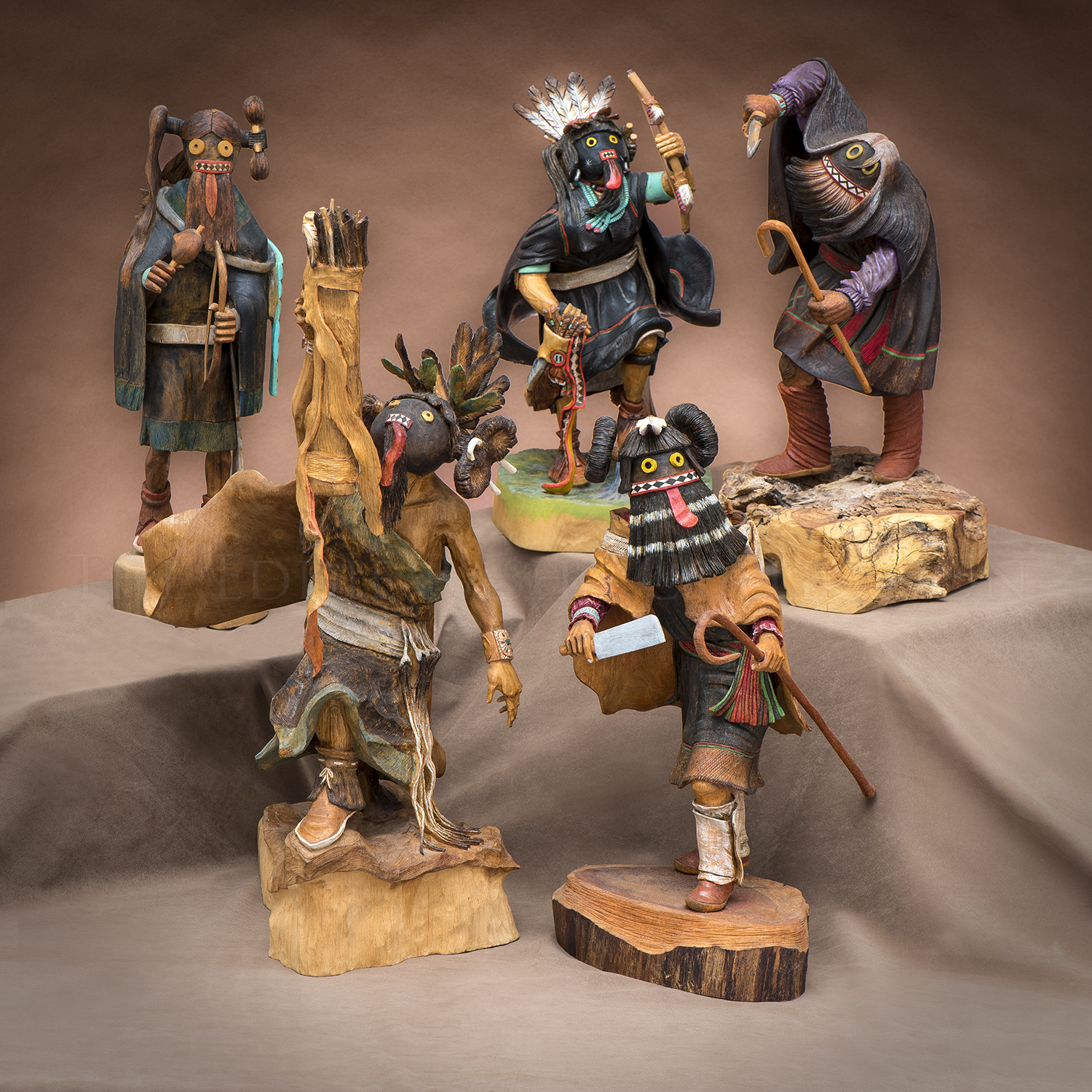
Mana or Soyok Wuhti Hopi Katsinam
Artist: Hopi
Description: Cottonwood Tree Rootkatsina
Top Row Left: Aaron Fred; Dimensions: 16”h x 5”w x 5”d
Top Row Center: Dennis Tewa (1945-2013); Dimensions: 15”h x 8”w x 7”d
Top Row Right: Loren Phillips (b.1942); Dimensions: 16”h x 9”w x 9”d
Bottom Row Left: Ros George (b.1948); Dimensions: 22”h x 12”w x 10”d
Bottom Row Right: Cecil Calnimptewa (b.1950); Dimensions: 16”h x 9”w x 9”d
The Mana or Soyok Wuhti appears in the Hopi Bean Dance, or Powamu Ceremony, as one of many ogres. Jagged teeth, wild eyes and often dressed in black while wielding a staff and long knife are a few of the physical features of this katsina. Her menacing appearance is meant to dissuade children from misbehaving. All were purchased from the artists directly at either the Heard Museum Guild Indian Market or at the Santa Fe Indian Market.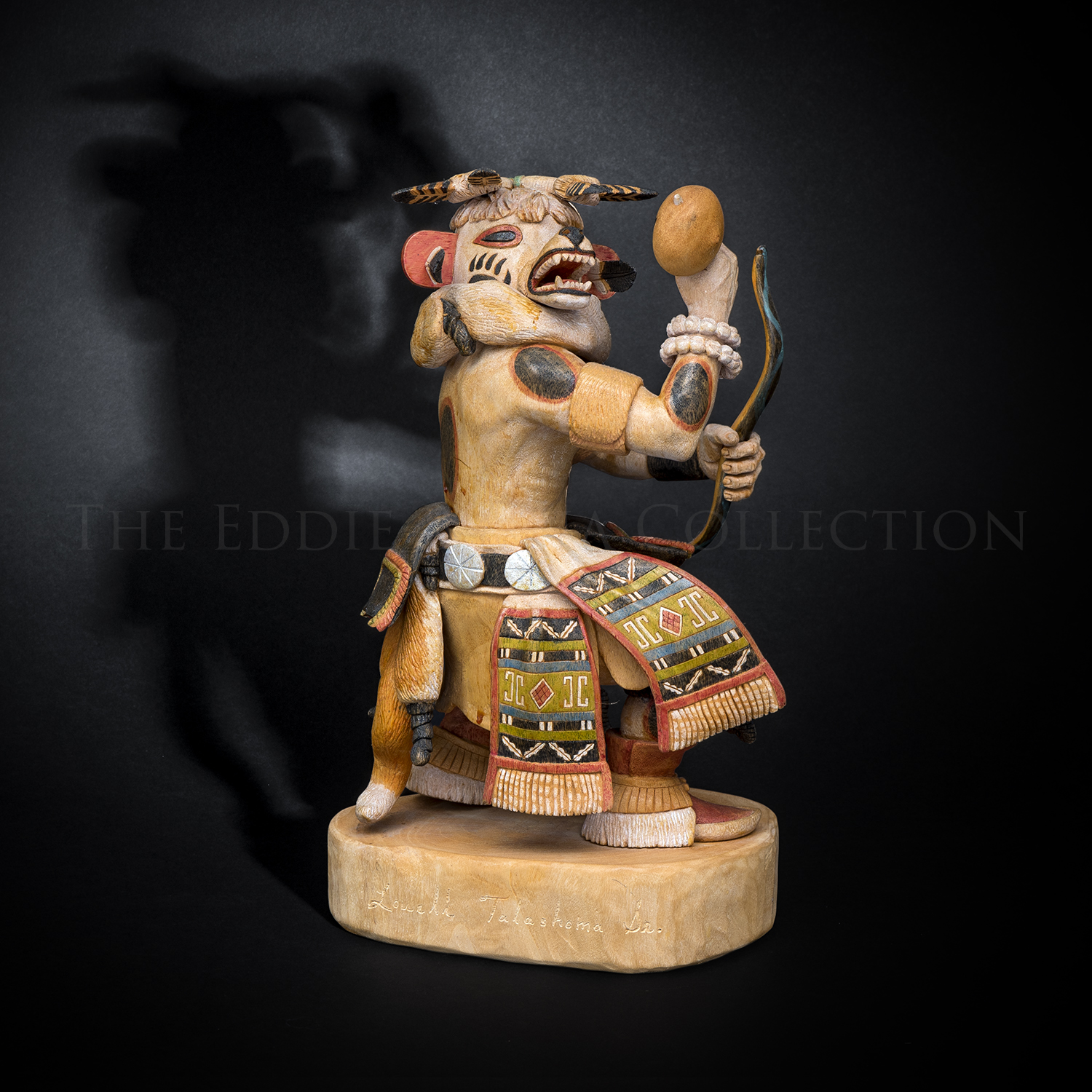
Ogre, the Disciplinarian | Lowell Talashoma (1950-2003)
Artist: Hopi
Description: Katsina/Cottonwood Root | Dimensions: 11”h x 7”w x 6”dkatsina
Though they appear quite intimidating, the ogre katsina are essentially disciplinarian clowns. At Hopi ceremonies they drum, dance, play games with the audience and may act as announcers at events. They often give prizes or awards for races and guessing games they organize.
Hopi katsina artist, Lowell Talashoma (1950-2003), was born on the reservation but raised by another family in Utah. His artistic abilities were apparent early on as he often drew illustrations for stories he’d read. On a particular visit to the reservation, Talashoma refused to return to Utah and from there he began to immerse himself in the Hopi culture. His carvings are known for their ability to convey movement and action and for their fine detailing. Several of his pieces were also cast in bronze. Talashoma garnered numerous awards throughout his career in competitions and exhibitions including top honors from shows at the Museum of Northern Arizona in Flagstaff, the Santa Fe Indian Market, and Gallup Inter-Tribal Ceremonials. He also won the Sandra Day O’Connor Special Award in the Katsina Category at the Heard Museum Guild’s Annual Indian Market.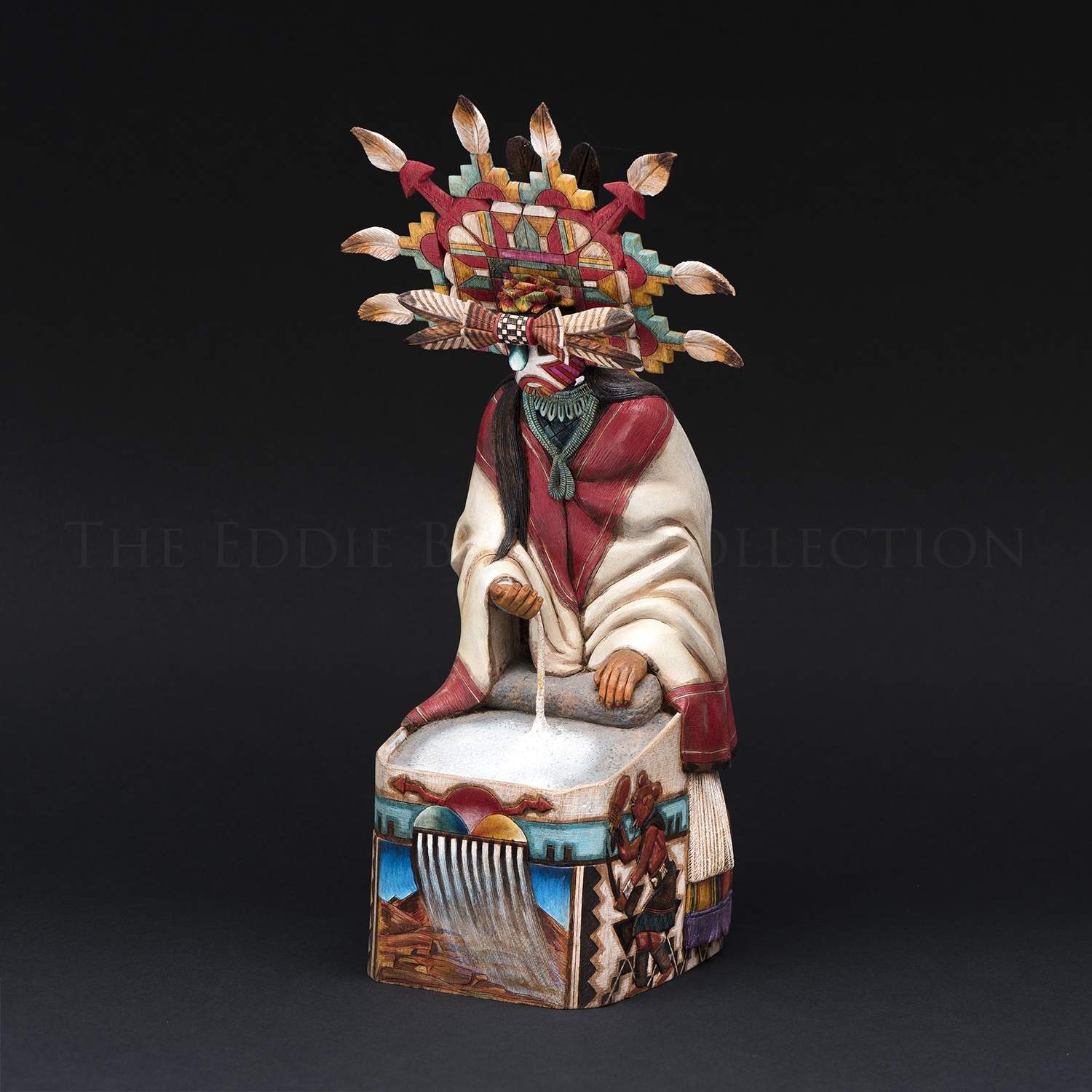
Palhik Mana (Grinding Corn) | Brian Honyouti (1947-2016)
Artist: Hopi
Description: Cottonwood Tree Root (2002) | Dimensions: 14 ¼”h x 7 ¼”w x 7”dkatsina
The Palhik Mana or Butterfly Maiden is holding a metate in her left hand and white cornmeal is streaming down to the stone from her right. She wears a wide, colorful tableta on her head with feathers along the sides and top. Her robe is white with a red band with small white stripes and a smaller width black band. The interior of a kiva scene with mudheads appears on three sides of the base while the front is a mountain view with rain descending over them. This katsina exudes Hopi symbolism.
Its artist, Brian Honyouti, learned his craft from his father when after graduating from high school during the 1960’s he began by assisting with the painting and later pressed on with carving. Brian was the first carver to utilize wood preservers and sealers as well as oil paints instead of acrylics. He attended the University of Arizona and graduated in 1971 with a degree in anthropology. A strong advocate of education, Brian not only founded a school in the Bacavi Village, but he was its teacher and principal.
Old Man Mudhead with Sleeping Little One | Arthur Holmes, Sr. (b.1945)
Artist: Hopi
Description: Cottonwood Tree Root | Dimensions: 16”h x 9”w x 8”dkatsina
Arthur Holmes, Sr. is recognized for his contemporary and realistic carvings of katsina. His attention to detail extends to the figures’ fingers and hands as well as folds in their sashes and skirts. For the Hopi, katsina are the bridge of the spiritual world and mortals. Each year katsina come, they walk upon the earth and they dance to bring life and renewal. When the katsina return to the spiritual world at the end of planting, they return with the prayers of the Hopi to continue on this earth for another round in the circle of life.
The Mudhead or Koyemsi are clowns that play the role of entertainers and bring laughter to the Hopi dances. Often seen drumming, dancing, playing games, awarding prizes and have even taken on the announcer role. They get their name from the mud that is applied to the masks worn around their heads.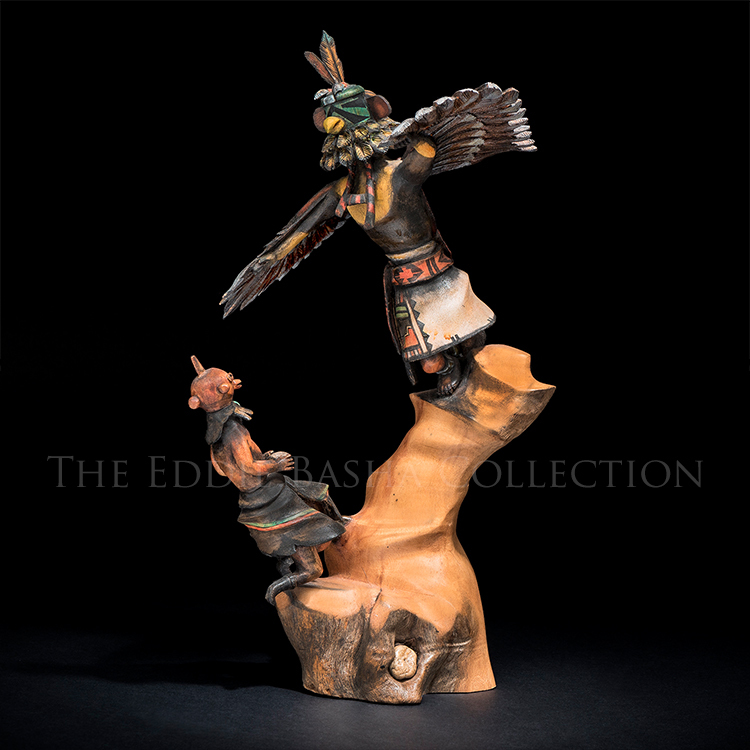
Eagle with Mudhead Katsina | Tom Fredericks (b.1973)
Artist: Hopi
Description: Cottonwood Tree Root | Dimensions: 15”h x 9”w x 5”dkatsina
The eagle katsina represents power and strength. The Hopi see him as ruler of the sky and as a messenger to the heavens. Mudhead katsina appear in almost all Hopi ceremonies as clowns, announcers of dances, drummers, and other roles. They often play guessing games with the audiences.
Carving since the mid-1980’s, Tom Fredericks is the son of Hopi master carver John Fredericks. He has developed a unique, naturally-stained finish that perfectly complements his sculpturally-styled dolls that portray the movement and motion of the katsina he carves.
Eagle Dancer Katsina | Jimmie G. Honanie, Jr. (1971-2009)
Artist: Hopi
Description: Cottonwood Tree Root (1995) | Dimensions: 22”h x 16”w x 14”dkatsina
Hopi carver Jimmie G. Honanie, Jr., studied and honed his skills under the tutelage of Loren Phillips eventually earning him the privilege of entering his masterworks at both the Heard Museum and Santa Fe Indian Market competitions.
The Kwahu, or eagle dancer, shown most often appears in the Kiva or Repeat Dances in early March. They dance is an effort to replicate the flight and motion of eagles and serves as a prayer for an increase in the eagle population. Amongst the Hopi it is thought that the eagle is a messenger between their people and the spirit guides.
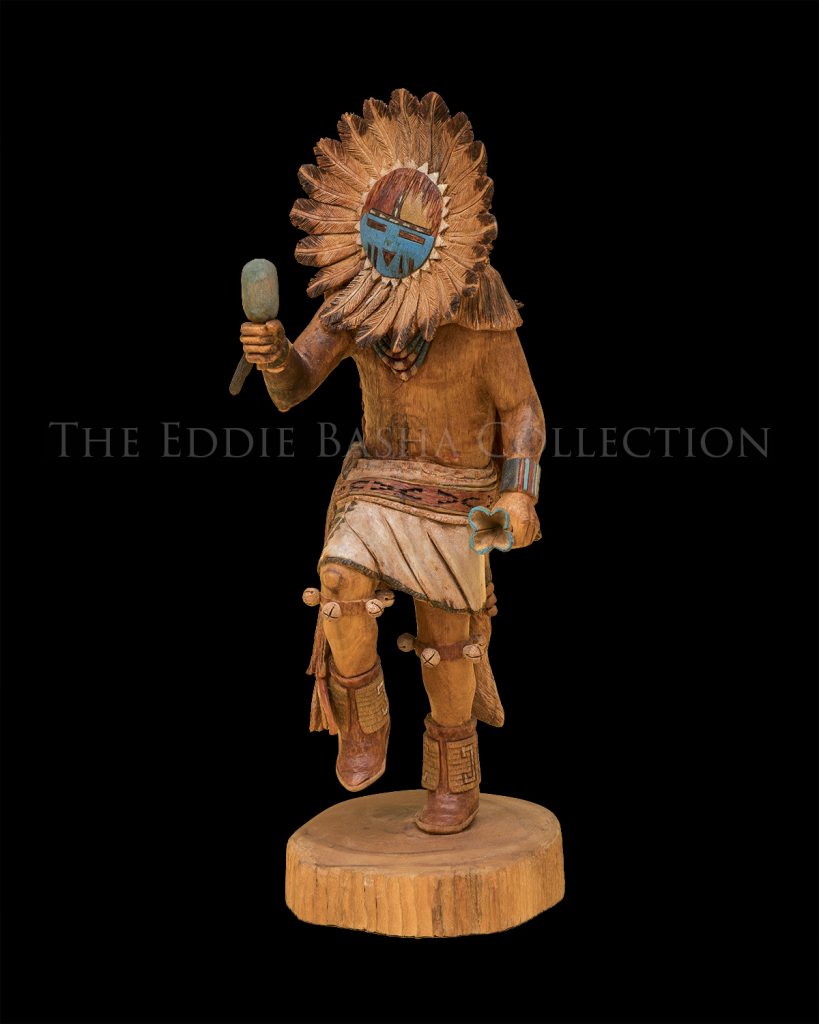 Cottonwood Tree Root | Dimensions: 15”h x 6”w x 5”d
Cottonwood Tree Root | Dimensions: 15”h x 6”w x 5”d This traditional Hopi carving by Wally Navasie is of a Taawa or Sun katsina that typically stands to the side in dances and can appear with a spruce tree in his left hand and a bell in his right. He may also appear in mixed dances with a flute in his left hand. Here, Navasie depicted Taawa with a gourd rattle in one hand and a flower in the other. The sun face represents warmth, shelter for the old, a bright future, and playfulness for the young.
Navasie was a Hopi carver from the First Mesa. He carved most of his life and was well known for his butterfly maidens and other sculptural pieces. He is featured in Theda Bassman’s book, “Hopi Kachina Dolls and Their Carvers.”
Taawa (Sun) Katsina | Wally Navasie (1962-2008)
Artist: Hopi
Description:
Cottonwood Tree Root | Dimensions: 15”h x 6”w x 5”d
This traditional Hopi carving by Wally Navasie is of a Taawa or Sun katsina that typically stands to the side in dances and can appear with a spruce tree in his left hand and a bell in his right. He may also appear in mixed dances with a flute in his left hand. Here, Navasie depicted Taawa with a gourd rattle in one hand and a flower in the other. The sun face represents warmth, shelter for the old, a bright future, and playfulness for the young.
Navasie was a Hopi carver from the First Mesa. He carved most of his life and was well known for his butterfly maidens and other sculptural pieces. He is featured in Theda Bassman’s book, “Hopi Kachina Dolls and Their Carvers.”
katsinaThis traditional Hopi carving by Wally Navasie is of a Taawa or Sun katsina that typically stands to the side in dances and can appear with a spruce tree in his left hand and a bell in his right. He may also appear in mixed dances with a flute in his left hand. Here, Navasie depicted Taawa with a gourd rattle in one hand and a flower in the other. The sun face represents warmth, shelter for the old, a bright future, and playfulness for the young.
Navasie was a Hopi carver from the First Mesa. He carved most of his life and was well known for his butterfly maidens and other sculptural pieces. He is featured in Theda Bassman’s book, “Hopi Kachina Dolls and Their Carvers.”
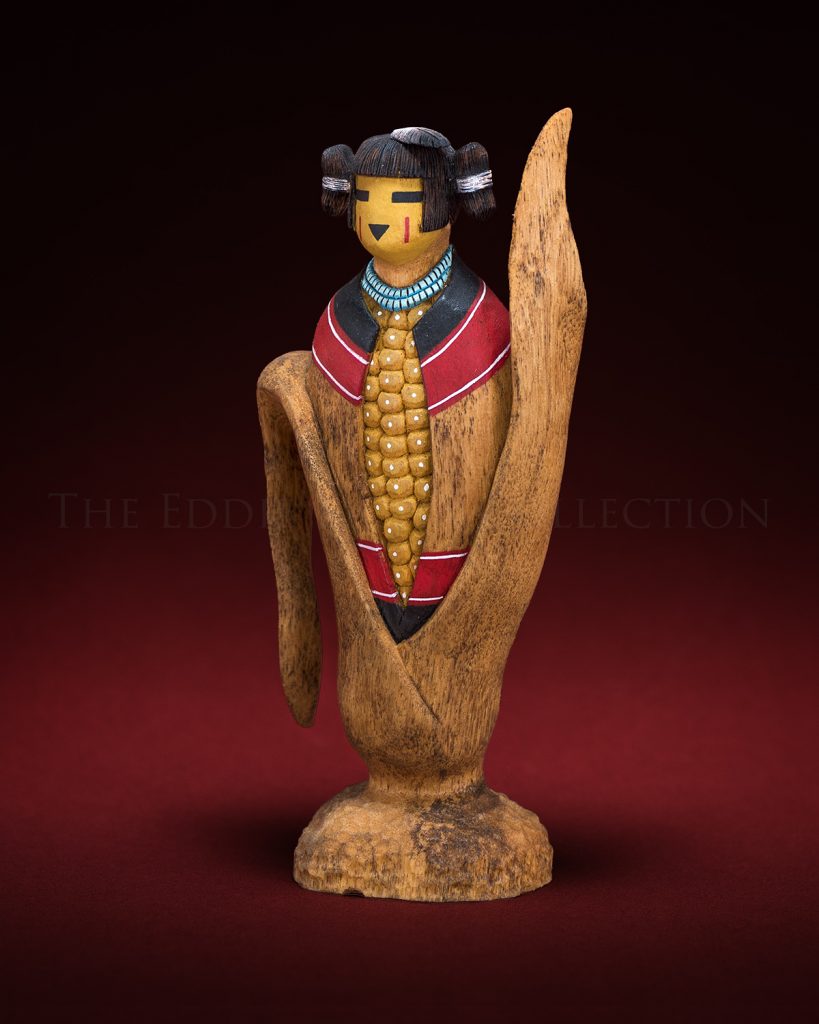 Cottonwood Tree Root (2006) | Dimensions: 6 ¾”h x 3”w x 2”d
Cottonwood Tree Root (2006) | Dimensions: 6 ¾”h x 3”w x 2”dThe petite-sized Corn Maiden by Maurice Tawesa Nutumya stands a mere 6 ¾” high. But its size doesn’t detract from its graceful, elegant lines. Her hair features traditional squash blossom, or butterfly whorls signifying her unmarried status as she emerges from the corn. As a maiden, she symbolizes potential, and the gifts received related to the growing and harvesting of corn.
Corn Maiden| Maurice Tawesa Nutumya | Maurice Tawesa Nutumya
Artist: Hopi
Description:
Cottonwood Tree Root (2006) | Dimensions: 6 ¾”h x 3”w x 2”d
The petite-sized Corn Maiden by Maurice Tawesa Nutumya stands a mere 6 ¾” high. But its size doesn’t detract from its graceful, elegant lines. Her hair features traditional squash blossom, or butterfly whorls signifying her unmarried status as she emerges from the corn. As a maiden, she symbolizes potential, and the gifts received related to the growing and harvesting of corn.
katsinaThe petite-sized Corn Maiden by Maurice Tawesa Nutumya stands a mere 6 ¾” high. But its size doesn’t detract from its graceful, elegant lines. Her hair features traditional squash blossom, or butterfly whorls signifying her unmarried status as she emerges from the corn. As a maiden, she symbolizes potential, and the gifts received related to the growing and harvesting of corn.
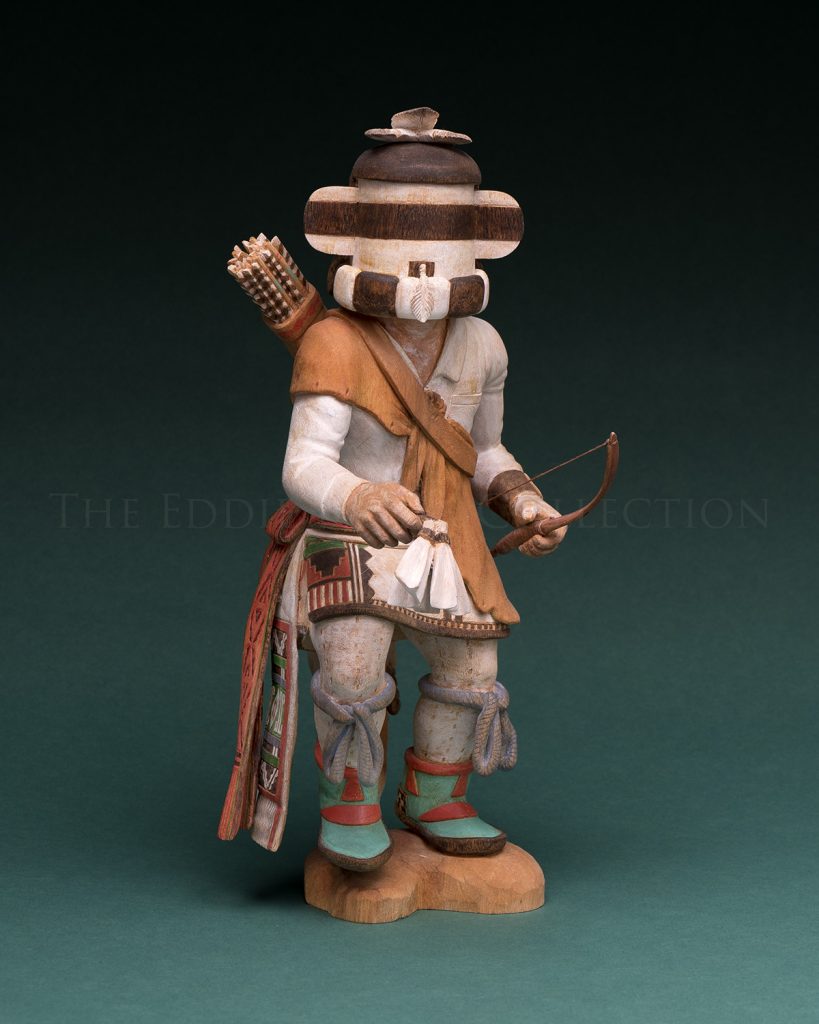 Cottonwood Tree Root | Dimensions: 13”h x 7”w x 6”d
Cottonwood Tree Root | Dimensions: 13”h x 7”w x 6”dThough originating from the Zuni culture, the Hopi adopted the “Hututu” katsina. It is known by the same name in both cultures and was derived by the sounds that he makes. He appears at the Bean Dance on First Mesa among other katsina. Here Hututu is depicted holding a bow in one hand, a quiver full of arrows slung over his shoulder, and an ornately brocaded hip sash tied around his waist.
Hopi katsina artist, Lowell Talashoma (1950-2003), was born on the reservation but raised by another family in Utah. His artistic abilities were apparent early on as he often drew illustrations for stories he’d read. On a particular visit to the reservation, Talashoma refused to return to Utah and from there he began to immerse himself in the Hopi culture. His carvings are known for their ability to convey movement and action and for their fine detailing. Several of his pieces were also cast in bronze. Talashoma garnered numerous awards throughout his career in competitions and exhibitions including top honors from shows at the Museum of Northern Arizona in Flagstaff, the Santa Fe Indian Market, and Gallup Inter-Tribal Ceremonials. He also won the Sandra Day O’Connor Special Award in the Katsina Category at the Heard Museum Guild’s Annual Indian Market.
Hututu | Lowell Talashoma (1950-2003)
Artist: Hopi
Description:
Cottonwood Tree Root | Dimensions: 13”h x 7”w x 6”d
Though originating from the Zuni culture, the Hopi adopted the “Hututu” katsina. It is known by the same name in both cultures and was derived by the sounds that he makes. He appears at the Bean Dance on First Mesa among other katsina. Here Hututu is depicted holding a bow in one hand, a quiver full of arrows slung over his shoulder, and an ornately brocaded hip sash tied around his waist.
Hopi katsina artist, Lowell Talashoma (1950-2003), was born on the reservation but raised by another family in Utah. His artistic abilities were apparent early on as he often drew illustrations for stories he’d read. On a particular visit to the reservation, Talashoma refused to return to Utah and from there he began to immerse himself in the Hopi culture. His carvings are known for their ability to convey movement and action and for their fine detailing. Several of his pieces were also cast in bronze. Talashoma garnered numerous awards throughout his career in competitions and exhibitions including top honors from shows at the Museum of Northern Arizona in Flagstaff, the Santa Fe Indian Market, and Gallup Inter-Tribal Ceremonials. He also won the Sandra Day O’Connor Special Award in the Katsina Category at the Heard Museum Guild’s Annual Indian Market.
katsinaThough originating from the Zuni culture, the Hopi adopted the “Hututu” katsina. It is known by the same name in both cultures and was derived by the sounds that he makes. He appears at the Bean Dance on First Mesa among other katsina. Here Hututu is depicted holding a bow in one hand, a quiver full of arrows slung over his shoulder, and an ornately brocaded hip sash tied around his waist.
Hopi katsina artist, Lowell Talashoma (1950-2003), was born on the reservation but raised by another family in Utah. His artistic abilities were apparent early on as he often drew illustrations for stories he’d read. On a particular visit to the reservation, Talashoma refused to return to Utah and from there he began to immerse himself in the Hopi culture. His carvings are known for their ability to convey movement and action and for their fine detailing. Several of his pieces were also cast in bronze. Talashoma garnered numerous awards throughout his career in competitions and exhibitions including top honors from shows at the Museum of Northern Arizona in Flagstaff, the Santa Fe Indian Market, and Gallup Inter-Tribal Ceremonials. He also won the Sandra Day O’Connor Special Award in the Katsina Category at the Heard Museum Guild’s Annual Indian Market.
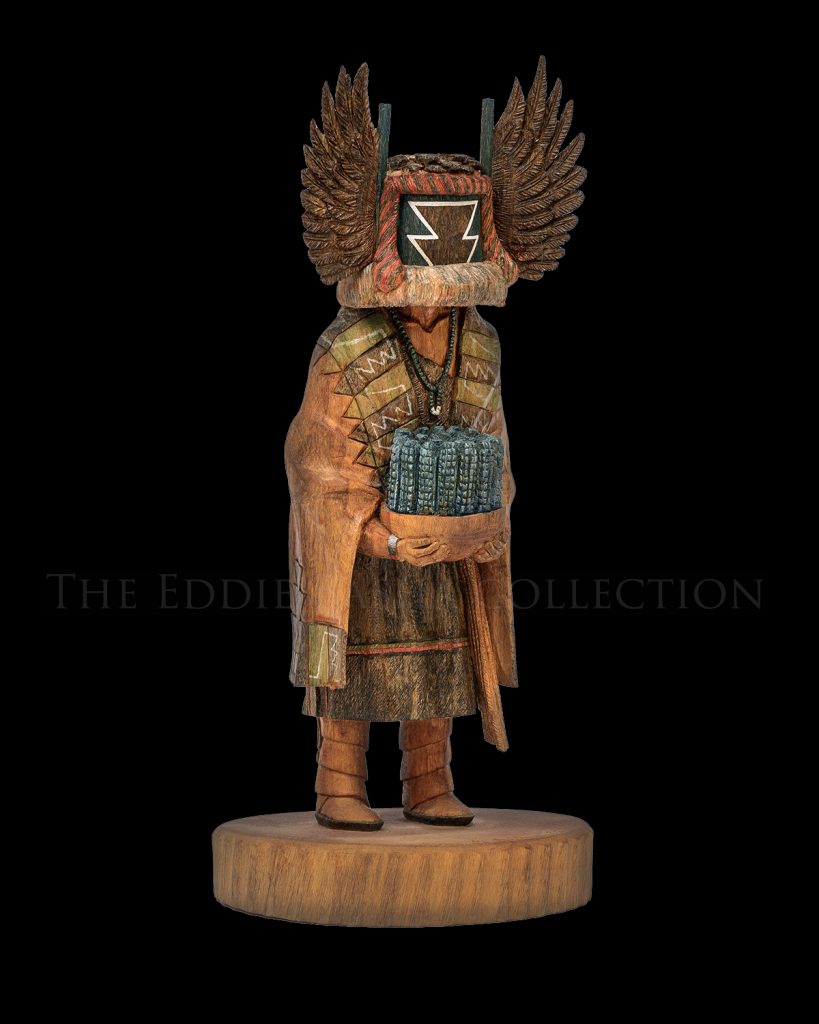 Cottonwood Tree Root (1986) | Dimensions: 15”h x 7”w x 5”d
Cottonwood Tree Root (1986) | Dimensions: 15”h x 7”w x 5”dBlue Corn Maidens typically appear at the Soyal Ceremony, December 21, which marks the winter solstice as the shortest day of the year. Participants ceremonially bring the sun back from its long slumber, mark the beginning of another cycle of the wheel of the year and work on purification. Blue Corn Maiden’s presence is a prayer for corn. She also honors Mother Earth for her continuing ability to feed her children. She is a reminder for all people to be thankful for their many gifts.
Blue Corn Maiden | Leon L. Dallas (b.1960)
Artist: Hopi
Description:
Cottonwood Tree Root (1986) | Dimensions: 15”h x 7”w x 5”d
Blue Corn Maidens typically appear at the Soyal Ceremony, December 21, which marks the winter solstice as the shortest day of the year. Participants ceremonially bring the sun back from its long slumber, mark the beginning of another cycle of the wheel of the year and work on purification. Blue Corn Maiden’s presence is a prayer for corn. She also honors Mother Earth for her continuing ability to feed her children. She is a reminder for all people to be thankful for their many gifts.
katsinaBlue Corn Maidens typically appear at the Soyal Ceremony, December 21, which marks the winter solstice as the shortest day of the year. Participants ceremonially bring the sun back from its long slumber, mark the beginning of another cycle of the wheel of the year and work on purification. Blue Corn Maiden’s presence is a prayer for corn. She also honors Mother Earth for her continuing ability to feed her children. She is a reminder for all people to be thankful for their many gifts.
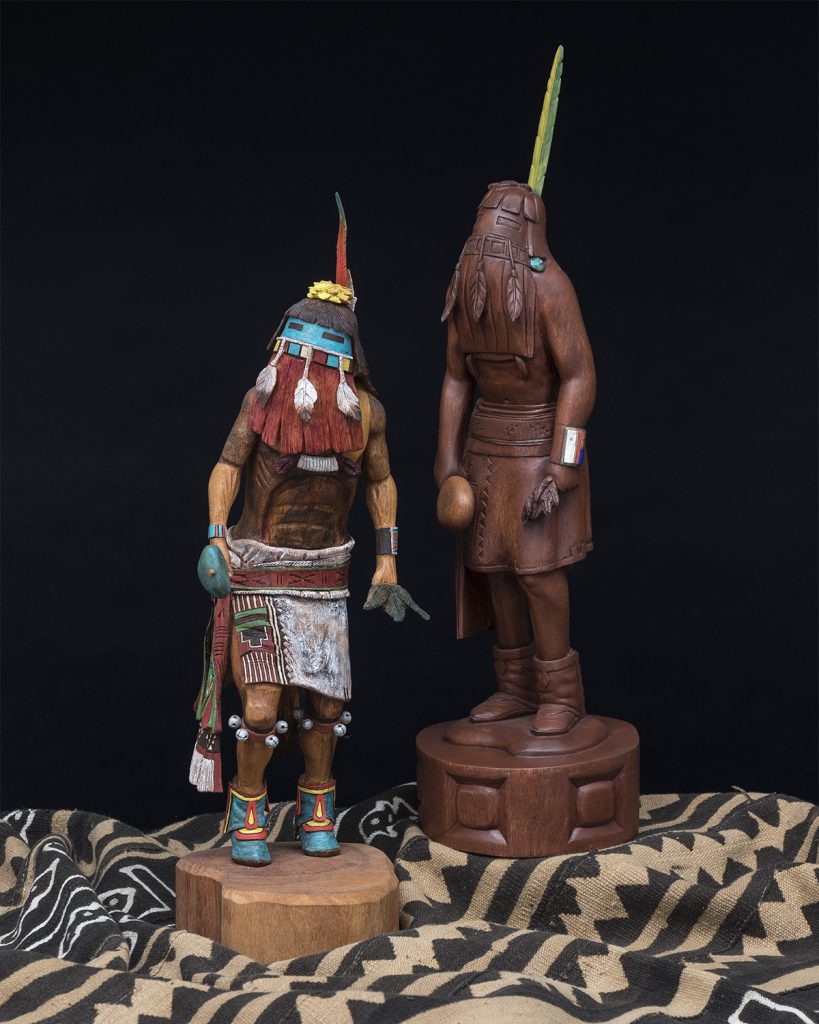 Cottonwood Tree Root | Dimensions: 20”h x 5”w x 8”d (Left)
Cottonwood Tree Root | Dimensions: 20”h x 5”w x 8”d (Left)Cottonwood Tree Root | Dimensions: 21 ½”h x 7”w x 7”d (Right)
The Hopi Long-Haired Katsina (Angak’cchina) is the bringer of gentle rains and flowers. The long hair worn loose down the back resembles the falling rain with the eagle breast plums rising like clouds above.
Each of the master carvers, Cecil Calnimptewa (left) and Brian Honyouti (right), conveyed their own interpretation. While Calnimptewa chose a traditional painted path, Honyouti chose a nod to modernity and incorporated natural materials such as turquois nuggets for the earbobs and gold, silver, coral, lapis and petrified wood for the bracelet.
Red-Bearded Long Haired Katsina (Left) | Cecil Calnimptewa (b. 1950) Red-Bearded Long Haired Katsina (Right) | Brian Honyouti (1947-2016)
Artist: Hopi
Description:
Cottonwood Tree Root | Dimensions: 20”h x 5”w x 8”d (Left)
Cottonwood Tree Root | Dimensions: 21 ½”h x 7”w x 7”d (Right)
The Hopi Long-Haired Katsina (Angak’cchina) is the bringer of gentle rains and flowers. The long hair worn loose down the back resembles the falling rain with the eagle breast plums rising like clouds above.
Each of the master carvers, Cecil Calnimptewa (left) and Brian Honyouti (right), conveyed their own interpretation. While Calnimptewa chose a traditional painted path, Honyouti chose a nod to modernity and incorporated natural materials such as turquois nuggets for the earbobs and gold, silver, coral, lapis and petrified wood for the bracelet.
katsinaCottonwood Tree Root | Dimensions: 21 ½”h x 7”w x 7”d (Right)
The Hopi Long-Haired Katsina (Angak’cchina) is the bringer of gentle rains and flowers. The long hair worn loose down the back resembles the falling rain with the eagle breast plums rising like clouds above.
Each of the master carvers, Cecil Calnimptewa (left) and Brian Honyouti (right), conveyed their own interpretation. While Calnimptewa chose a traditional painted path, Honyouti chose a nod to modernity and incorporated natural materials such as turquois nuggets for the earbobs and gold, silver, coral, lapis and petrified wood for the bracelet.
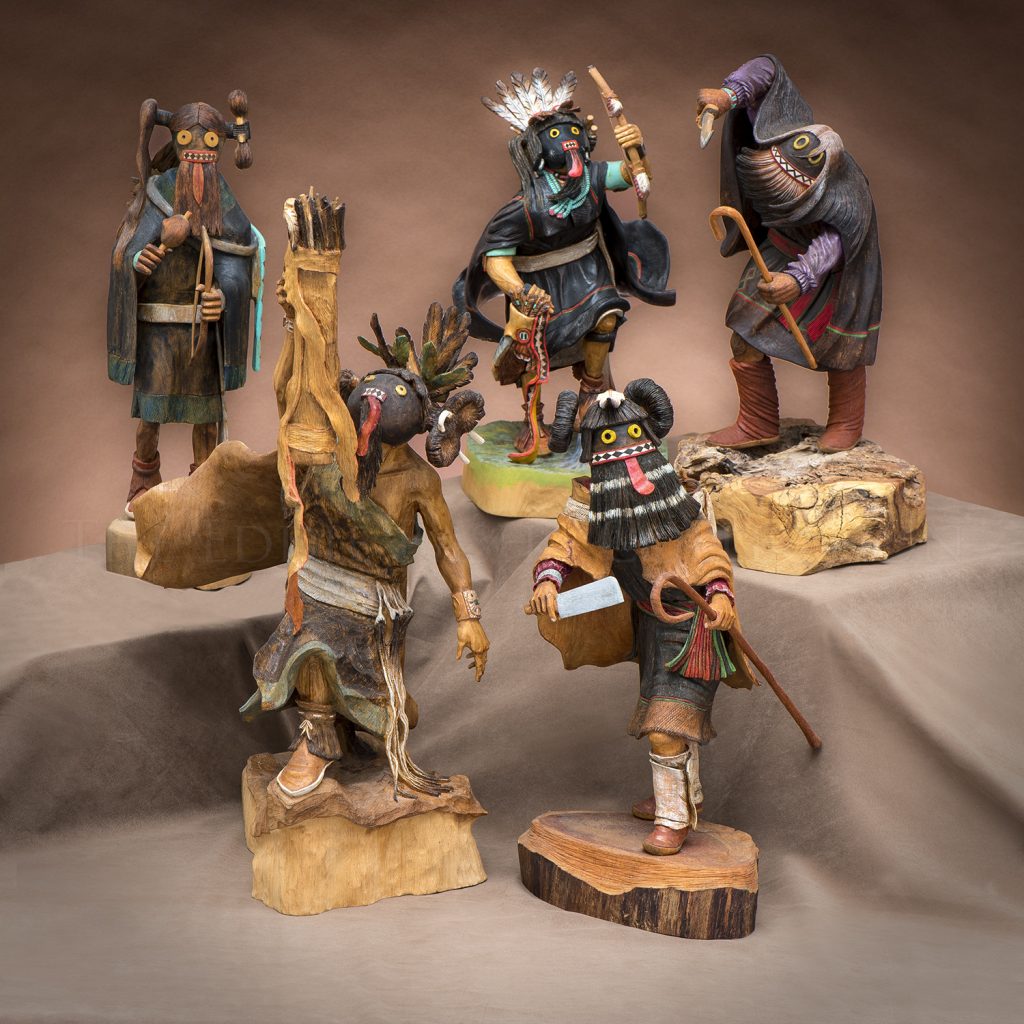 Cottonwood Tree Root
Cottonwood Tree RootTop Row Left: Aaron Fred; Dimensions: 16”h x 5”w x 5”d
Top Row Center: Dennis Tewa (1945-2013); Dimensions: 15”h x 8”w x 7”d
Top Row Right: Loren Phillips (b.1942); Dimensions: 16”h x 9”w x 9”d
Bottom Row Left: Ros George (b.1948); Dimensions: 22”h x 12”w x 10”d
Bottom Row Right: Cecil Calnimptewa (b.1950); Dimensions: 16”h x 9”w x 9”d
The Mana or Soyok Wuhti appears in the Hopi Bean Dance, or Powamu Ceremony, as one of many ogres. Jagged teeth, wild eyes and often dressed in black while wielding a staff and long knife are a few of the physical features of this katsina. Her menacing appearance is meant to dissuade children from misbehaving. All were purchased from the artists directly at either the Heard Museum Guild Indian Market or at the Santa Fe Indian Market.
Mana or Soyok Wuhti Hopi Katsinam
Artist: Hopi
Description:
Cottonwood Tree Root
Top Row Left: Aaron Fred; Dimensions: 16”h x 5”w x 5”d
Top Row Center: Dennis Tewa (1945-2013); Dimensions: 15”h x 8”w x 7”d
Top Row Right: Loren Phillips (b.1942); Dimensions: 16”h x 9”w x 9”d
Bottom Row Left: Ros George (b.1948); Dimensions: 22”h x 12”w x 10”d
Bottom Row Right: Cecil Calnimptewa (b.1950); Dimensions: 16”h x 9”w x 9”d
The Mana or Soyok Wuhti appears in the Hopi Bean Dance, or Powamu Ceremony, as one of many ogres. Jagged teeth, wild eyes and often dressed in black while wielding a staff and long knife are a few of the physical features of this katsina. Her menacing appearance is meant to dissuade children from misbehaving. All were purchased from the artists directly at either the Heard Museum Guild Indian Market or at the Santa Fe Indian Market.
katsinaTop Row Left: Aaron Fred; Dimensions: 16”h x 5”w x 5”d
Top Row Center: Dennis Tewa (1945-2013); Dimensions: 15”h x 8”w x 7”d
Top Row Right: Loren Phillips (b.1942); Dimensions: 16”h x 9”w x 9”d
Bottom Row Left: Ros George (b.1948); Dimensions: 22”h x 12”w x 10”d
Bottom Row Right: Cecil Calnimptewa (b.1950); Dimensions: 16”h x 9”w x 9”d
The Mana or Soyok Wuhti appears in the Hopi Bean Dance, or Powamu Ceremony, as one of many ogres. Jagged teeth, wild eyes and often dressed in black while wielding a staff and long knife are a few of the physical features of this katsina. Her menacing appearance is meant to dissuade children from misbehaving. All were purchased from the artists directly at either the Heard Museum Guild Indian Market or at the Santa Fe Indian Market.
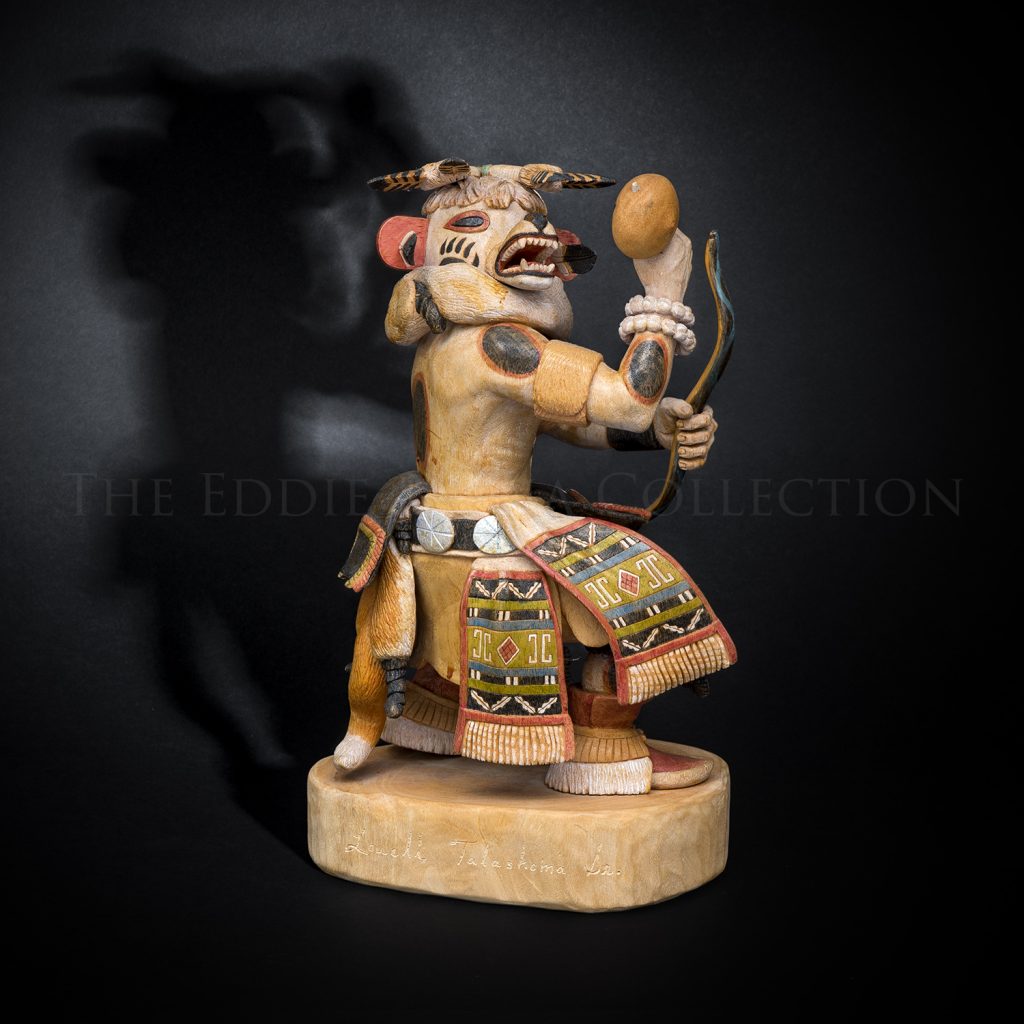 Katsina/Cottonwood Root | Dimensions: 11”h x 7”w x 6”d
Katsina/Cottonwood Root | Dimensions: 11”h x 7”w x 6”dThough they appear quite intimidating, the ogre katsina are essentially disciplinarian clowns. At Hopi ceremonies they drum, dance, play games with the audience and may act as announcers at events. They often give prizes or awards for races and guessing games they organize.
Hopi katsina artist, Lowell Talashoma (1950-2003), was born on the reservation but raised by another family in Utah. His artistic abilities were apparent early on as he often drew illustrations for stories he’d read. On a particular visit to the reservation, Talashoma refused to return to Utah and from there he began to immerse himself in the Hopi culture. His carvings are known for their ability to convey movement and action and for their fine detailing. Several of his pieces were also cast in bronze. Talashoma garnered numerous awards throughout his career in competitions and exhibitions including top honors from shows at the Museum of Northern Arizona in Flagstaff, the Santa Fe Indian Market, and Gallup Inter-Tribal Ceremonials. He also won the Sandra Day O’Connor Special Award in the Katsina Category at the Heard Museum Guild’s Annual Indian Market.
Ogre, the Disciplinarian | Lowell Talashoma (1950-2003)
Artist: Hopi
Description:
Katsina/Cottonwood Root | Dimensions: 11”h x 7”w x 6”d
Though they appear quite intimidating, the ogre katsina are essentially disciplinarian clowns. At Hopi ceremonies they drum, dance, play games with the audience and may act as announcers at events. They often give prizes or awards for races and guessing games they organize.
Hopi katsina artist, Lowell Talashoma (1950-2003), was born on the reservation but raised by another family in Utah. His artistic abilities were apparent early on as he often drew illustrations for stories he’d read. On a particular visit to the reservation, Talashoma refused to return to Utah and from there he began to immerse himself in the Hopi culture. His carvings are known for their ability to convey movement and action and for their fine detailing. Several of his pieces were also cast in bronze. Talashoma garnered numerous awards throughout his career in competitions and exhibitions including top honors from shows at the Museum of Northern Arizona in Flagstaff, the Santa Fe Indian Market, and Gallup Inter-Tribal Ceremonials. He also won the Sandra Day O’Connor Special Award in the Katsina Category at the Heard Museum Guild’s Annual Indian Market.
katsinaThough they appear quite intimidating, the ogre katsina are essentially disciplinarian clowns. At Hopi ceremonies they drum, dance, play games with the audience and may act as announcers at events. They often give prizes or awards for races and guessing games they organize.
Hopi katsina artist, Lowell Talashoma (1950-2003), was born on the reservation but raised by another family in Utah. His artistic abilities were apparent early on as he often drew illustrations for stories he’d read. On a particular visit to the reservation, Talashoma refused to return to Utah and from there he began to immerse himself in the Hopi culture. His carvings are known for their ability to convey movement and action and for their fine detailing. Several of his pieces were also cast in bronze. Talashoma garnered numerous awards throughout his career in competitions and exhibitions including top honors from shows at the Museum of Northern Arizona in Flagstaff, the Santa Fe Indian Market, and Gallup Inter-Tribal Ceremonials. He also won the Sandra Day O’Connor Special Award in the Katsina Category at the Heard Museum Guild’s Annual Indian Market.
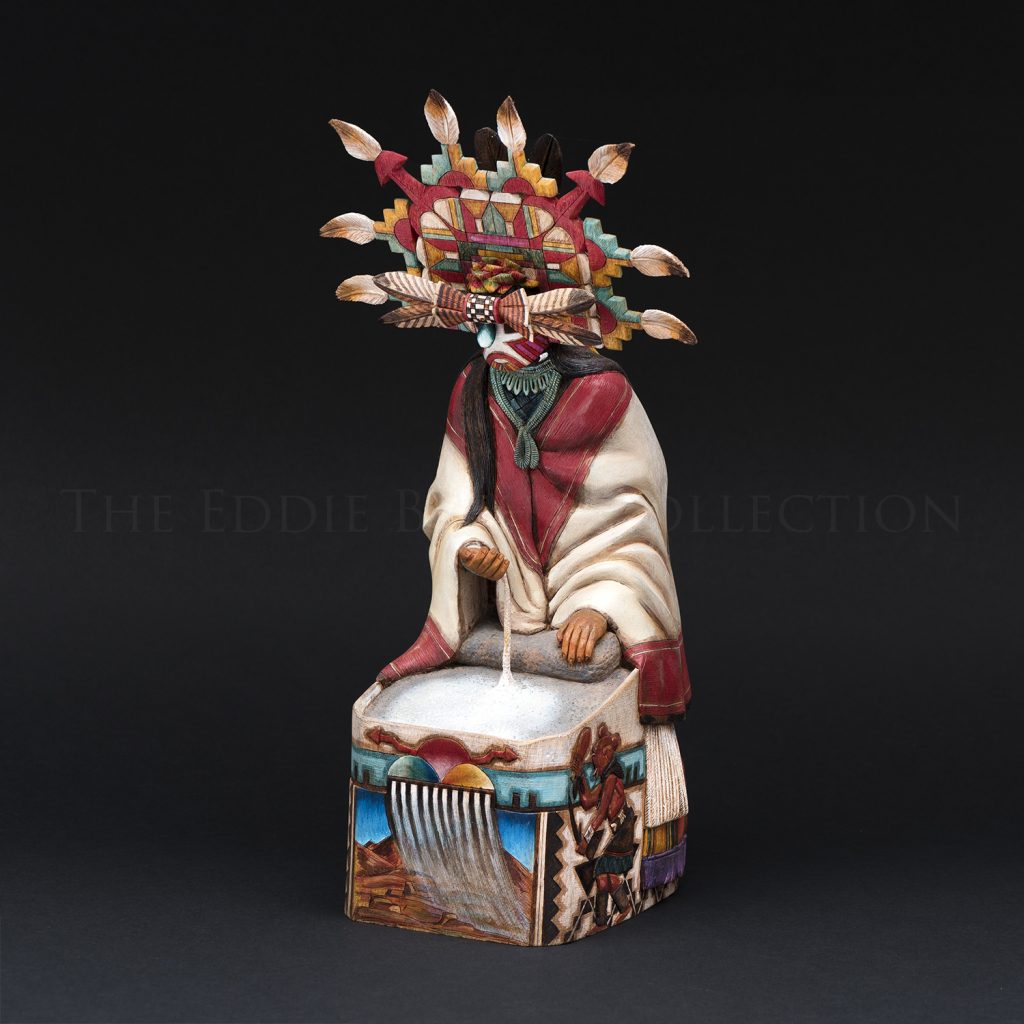 Cottonwood Tree Root (2002) | Dimensions: 14 ¼”h x 7 ¼”w x 7”d
Cottonwood Tree Root (2002) | Dimensions: 14 ¼”h x 7 ¼”w x 7”dThe Palhik Mana or Butterfly Maiden is holding a metate in her left hand and white cornmeal is streaming down to the stone from her right. She wears a wide, colorful tableta on her head with feathers along the sides and top. Her robe is white with a red band with small white stripes and a smaller width black band. The interior of a kiva scene with mudheads appears on three sides of the base while the front is a mountain view with rain descending over them. This katsina exudes Hopi symbolism.
Its artist, Brian Honyouti, learned his craft from his father when after graduating from high school during the 1960’s he began by assisting with the painting and later pressed on with carving. Brian was the first carver to utilize wood preservers and sealers as well as oil paints instead of acrylics. He attended the University of Arizona and graduated in 1971 with a degree in anthropology. A strong advocate of education, Brian not only founded a school in the Bacavi Village, but he was its teacher and principal.
Palhik Mana (Grinding Corn) | Brian Honyouti (1947-2016)
Artist: Hopi
Description:
Cottonwood Tree Root (2002) | Dimensions: 14 ¼”h x 7 ¼”w x 7”d
The Palhik Mana or Butterfly Maiden is holding a metate in her left hand and white cornmeal is streaming down to the stone from her right. She wears a wide, colorful tableta on her head with feathers along the sides and top. Her robe is white with a red band with small white stripes and a smaller width black band. The interior of a kiva scene with mudheads appears on three sides of the base while the front is a mountain view with rain descending over them. This katsina exudes Hopi symbolism.
Its artist, Brian Honyouti, learned his craft from his father when after graduating from high school during the 1960’s he began by assisting with the painting and later pressed on with carving. Brian was the first carver to utilize wood preservers and sealers as well as oil paints instead of acrylics. He attended the University of Arizona and graduated in 1971 with a degree in anthropology. A strong advocate of education, Brian not only founded a school in the Bacavi Village, but he was its teacher and principal.
katsinaThe Palhik Mana or Butterfly Maiden is holding a metate in her left hand and white cornmeal is streaming down to the stone from her right. She wears a wide, colorful tableta on her head with feathers along the sides and top. Her robe is white with a red band with small white stripes and a smaller width black band. The interior of a kiva scene with mudheads appears on three sides of the base while the front is a mountain view with rain descending over them. This katsina exudes Hopi symbolism.
Its artist, Brian Honyouti, learned his craft from his father when after graduating from high school during the 1960’s he began by assisting with the painting and later pressed on with carving. Brian was the first carver to utilize wood preservers and sealers as well as oil paints instead of acrylics. He attended the University of Arizona and graduated in 1971 with a degree in anthropology. A strong advocate of education, Brian not only founded a school in the Bacavi Village, but he was its teacher and principal.
 Cottonwood Tree Root | Dimensions: 16”h x 9”w x 8”d
Cottonwood Tree Root | Dimensions: 16”h x 9”w x 8”dArthur Holmes, Sr. is recognized for his contemporary and realistic carvings of katsina. His attention to detail extends to the figures’ fingers and hands as well as folds in their sashes and skirts. For the Hopi, katsina are the bridge of the spiritual world and mortals. Each year katsina come, they walk upon the earth and they dance to bring life and renewal. When the katsina return to the spiritual world at the end of planting, they return with the prayers of the Hopi to continue on this earth for another round in the circle of life.
The Mudhead or Koyemsi are clowns that play the role of entertainers and bring laughter to the Hopi dances. Often seen drumming, dancing, playing games, awarding prizes and have even taken on the announcer role. They get their name from the mud that is applied to the masks worn around their heads.
Old Man Mudhead with Sleeping Little One | Arthur Holmes, Sr. (b.1945)
Artist: Hopi
Description:
Cottonwood Tree Root | Dimensions: 16”h x 9”w x 8”d
Arthur Holmes, Sr. is recognized for his contemporary and realistic carvings of katsina. His attention to detail extends to the figures’ fingers and hands as well as folds in their sashes and skirts. For the Hopi, katsina are the bridge of the spiritual world and mortals. Each year katsina come, they walk upon the earth and they dance to bring life and renewal. When the katsina return to the spiritual world at the end of planting, they return with the prayers of the Hopi to continue on this earth for another round in the circle of life.
The Mudhead or Koyemsi are clowns that play the role of entertainers and bring laughter to the Hopi dances. Often seen drumming, dancing, playing games, awarding prizes and have even taken on the announcer role. They get their name from the mud that is applied to the masks worn around their heads.
katsinaArthur Holmes, Sr. is recognized for his contemporary and realistic carvings of katsina. His attention to detail extends to the figures’ fingers and hands as well as folds in their sashes and skirts. For the Hopi, katsina are the bridge of the spiritual world and mortals. Each year katsina come, they walk upon the earth and they dance to bring life and renewal. When the katsina return to the spiritual world at the end of planting, they return with the prayers of the Hopi to continue on this earth for another round in the circle of life.
The Mudhead or Koyemsi are clowns that play the role of entertainers and bring laughter to the Hopi dances. Often seen drumming, dancing, playing games, awarding prizes and have even taken on the announcer role. They get their name from the mud that is applied to the masks worn around their heads.
 Cottonwood Tree Root | Dimensions: 15”h x 9”w x 5”d
Cottonwood Tree Root | Dimensions: 15”h x 9”w x 5”dThe eagle katsina represents power and strength. The Hopi see him as ruler of the sky and as a messenger to the heavens. Mudhead katsina appear in almost all Hopi ceremonies as clowns, announcers of dances, drummers, and other roles. They often play guessing games with the audiences.
Carving since the mid-1980’s, Tom Fredericks is the son of Hopi master carver John Fredericks. He has developed a unique, naturally-stained finish that perfectly complements his sculpturally-styled dolls that portray the movement and motion of the katsina he carves.
Eagle with Mudhead Katsina | Tom Fredericks (b.1973)
Artist: Hopi
Description:
Cottonwood Tree Root | Dimensions: 15”h x 9”w x 5”d
The eagle katsina represents power and strength. The Hopi see him as ruler of the sky and as a messenger to the heavens. Mudhead katsina appear in almost all Hopi ceremonies as clowns, announcers of dances, drummers, and other roles. They often play guessing games with the audiences.
Carving since the mid-1980’s, Tom Fredericks is the son of Hopi master carver John Fredericks. He has developed a unique, naturally-stained finish that perfectly complements his sculpturally-styled dolls that portray the movement and motion of the katsina he carves.
katsinaThe eagle katsina represents power and strength. The Hopi see him as ruler of the sky and as a messenger to the heavens. Mudhead katsina appear in almost all Hopi ceremonies as clowns, announcers of dances, drummers, and other roles. They often play guessing games with the audiences.
Carving since the mid-1980’s, Tom Fredericks is the son of Hopi master carver John Fredericks. He has developed a unique, naturally-stained finish that perfectly complements his sculpturally-styled dolls that portray the movement and motion of the katsina he carves.
 Cottonwood Tree Root (1995) | Dimensions: 22”h x 16”w x 14”d
Cottonwood Tree Root (1995) | Dimensions: 22”h x 16”w x 14”dHopi carver Jimmie G. Honanie, Jr., studied and honed his skills under the tutelage of Loren Phillips eventually earning him the privilege of entering his masterworks at both the Heard Museum and Santa Fe Indian Market competitions.
The Kwahu, or eagle dancer, shown most often appears in the Kiva or Repeat Dances in early March. They dance is an effort to replicate the flight and motion of eagles and serves as a prayer for an increase in the eagle population. Amongst the Hopi it is thought that the eagle is a messenger between their people and the spirit guides.
Eagle Dancer Katsina | Jimmie G. Honanie, Jr. (1971-2009)
Artist: Hopi
Description:
Cottonwood Tree Root (1995) | Dimensions: 22”h x 16”w x 14”d
Hopi carver Jimmie G. Honanie, Jr., studied and honed his skills under the tutelage of Loren Phillips eventually earning him the privilege of entering his masterworks at both the Heard Museum and Santa Fe Indian Market competitions.
The Kwahu, or eagle dancer, shown most often appears in the Kiva or Repeat Dances in early March. They dance is an effort to replicate the flight and motion of eagles and serves as a prayer for an increase in the eagle population. Amongst the Hopi it is thought that the eagle is a messenger between their people and the spirit guides.
katsinaHopi carver Jimmie G. Honanie, Jr., studied and honed his skills under the tutelage of Loren Phillips eventually earning him the privilege of entering his masterworks at both the Heard Museum and Santa Fe Indian Market competitions.
The Kwahu, or eagle dancer, shown most often appears in the Kiva or Repeat Dances in early March. They dance is an effort to replicate the flight and motion of eagles and serves as a prayer for an increase in the eagle population. Amongst the Hopi it is thought that the eagle is a messenger between their people and the spirit guides.